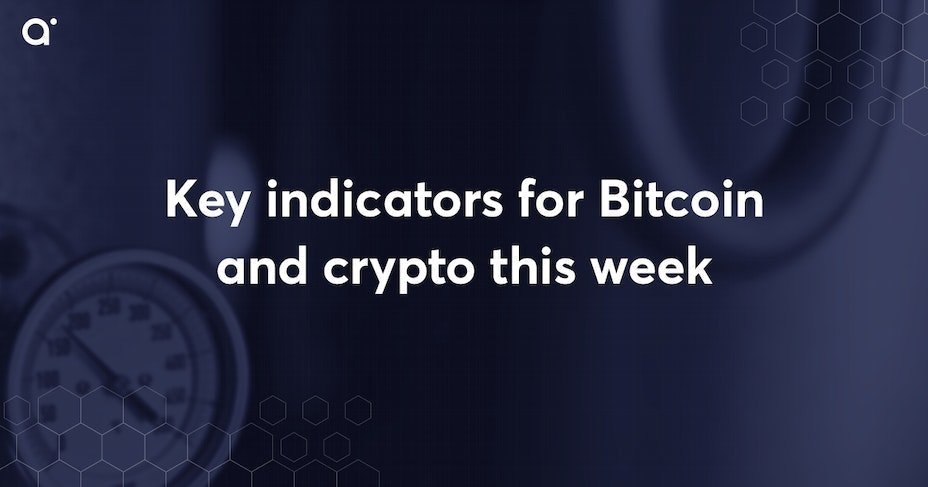Key Indicators for Bitcoin and Crypto - Trading Week 13
- 7 minute read

In the past trading week, the cryptocurrency Bitcoin (BTC) made little progress. Despite persistent problems in the banking sector, the US Federal Reserve Bank (Fed) raised interest rates again by 0.25% to 5.00% midweek. Although the BTC price briefly rose to a new high for the year of US$28,937, the gains were dispelled in the wake of another hawkish statement by Fed Chairman Jerome Powell during the press conference. Meanwhile, the banking sector in the US and Europe came under renewed pressure. The vast majority of financial institutions ended the week around their weekly lows. US account holders recently withdrew about US$100 billion from both large and small US financial institutions. Although the US Treasury reiterated after a joint meeting with the Fed and FDIC that the financial system is operating flawlessly and resiliently, US financial authorities recently considered extending the emergency lending facility to even more banks. These developments are important for the Bitcoin price this week:
✔️ Figures on consumer confidence in the US.;
✔️ Home sales in the US;
✔️ US Gross Domestic Product.;
✔️ Inflation data from Europe and core US inflation.

Inhoudsopgave
- Figures on US consumer confidence
- Home sales in the US
- US Gross Domestic Product
- Inflation data from Europe and core US inflation at the end of the week
Figures on US consumer confidence
On Tuesday 28 March, the Conference Board (CB) will release new US consumer confidence figures for the trading month of March at 16:00 (CET). The level of optimism about the US economy came in at 102.9 in February, well below expectations of 108.5, which again led to falling consumer confidence. For the month of March, market experts expect a further decline to 101.0. If the forecast is beaten, the US dollar index (DXY) will continue its upward movement from the previous week and this could act as a headwind for the Bitcoin price. On the other hand, if analysts' expectations are not met and consumer confidence remains even below expectations, the likelihood of a US recession increases further. Continued weak consumer confidence is likely to be welcomed by financial markets as it would further increase the chances of an interest rate cut in the coming months.
Home sales in the US
This Wednesday 29 March, we can look forward to the latest US existing-home sales figures at 16:00 (CET). Since sales of existing homes represent about 90% of the US housing market, this metric is an important component for assessing US consumer spending. After sales for the last calculation period were significantly above expectations of only +1.0% at +8.1%, analysts now expect a decline of -3.0%. If sales figures for existing homes turn out better than expected, this could indicate a further stabilisation of the recently weak housing market. A full-blown housing market crash is likely to exacerbate US banking problems and push the US economy into recession. As a result, the US Federal Reserve would have to cut interest rates sooner than planned. Paradoxically, the stock and crypto markets are likely to benefit from poor housing market data.
US Gross Domestic Product
Towards the end of the trading week, on Thursday 30 March, the final GDP figures will be released at 14:30 (CET) for the last quarter in 2022. In the last two pre-publications for the fourth quarter in January and February, market experts missed the published figures with their forecast. Currently, analysts expect economic growth of 2.7% in the last quarter of last year. Recently, experts were 0.2% below last February's forecast of 2.9%. If the final figures confirm the latest forecast of 2.7%, the market reaction could be positive. The Bitcoin price should then react bullish as well. Recently, market participants have been positive on strong GDP. Renewed weakness is likely to put further pressure on Jerome Powell. So it is conceivable that the market will view poor GDP data positively after all. Rarely have market players been so divided in their interpretation of this key indicator.
Inflation data from Europe and core US inflation at the end of the week
The trading week will end on Friday with inflation data from Europe and the US. At 11:00 (CET), early eurozone consumer price figures for March will be released. The forecast of 7.2% is significantly lower than the final inflation rate of 8.5% in the previous month. In particular, falling crude oil prices are likely to determine the lowered forecast again. Earlier, UK inflation figures were released. Contrary to expectations, inflation there rose to 10.4%. This could be an indication that the data for Europe could also be above expectations. Negative effects on the stock market are then likely to result. On the other hand, if analysts' expectations come true and are even lower than expected, the market could react positively. Both equities and crypto assets should then rise in value.
At 14:30 (CET), the Bureau of Economic Analysis presents the core PCE rate for the US in February. As in the previous month, a month-on-month increase of +0.4% is forecast. Last month, the PCE price index was already higher than market expectations at +0.6%. As a result, financial markets corrected downwards. If this trend continues, another weak ending of the week is expected on Friday. However, if core inflation has risen less than analysts expect, the stock market and also the Bitcoin price should benefit. But with the Fed recently shifting its focus from pure inflation to systemic risks in the banking sector, evaluating the data is becoming increasingly difficult.


